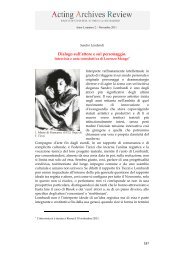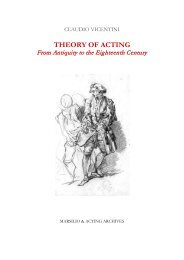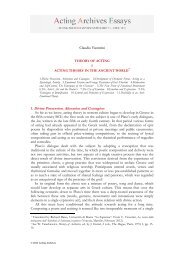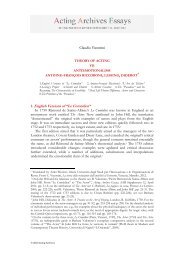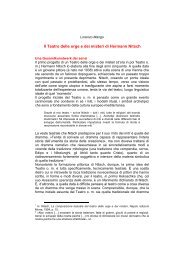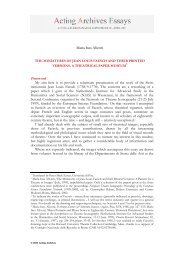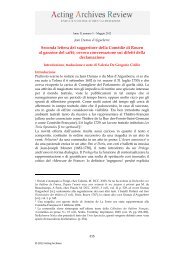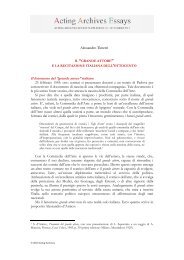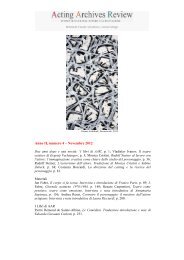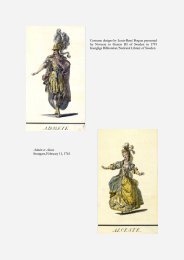Flavia Pappacena_Noverre's Lettres sur la Danse - Acting Archives
Flavia Pappacena_Noverre's Lettres sur la Danse - Acting Archives
Flavia Pappacena_Noverre's Lettres sur la Danse - Acting Archives
You also want an ePaper? Increase the reach of your titles
YUMPU automatically turns print PDFs into web optimized ePapers that Google loves.
AAR <strong>Acting</strong> <strong>Archives</strong> Essays Supplement 9 – April 2011<br />
extravagant effects and a picturesque ‘beau désordre’ 10 catering exclusively ‘to<br />
amusing the eye’. 11 Whereas in his description of the “grand” genre (La Mort d’Ajax,<br />
Le Jugement de Paris, La Descente d’Orphée aux Enfers, Renaud et Armide) we can recognise<br />
a certain affinity with the Spectacles put on by Servandoni at the Tuileries, but with<br />
greater emphasis on gesture and an unequivocally hedonistic interpretation of the<br />
episodes from antiquity.<br />
Although in staging Les Réjouissances f<strong>la</strong>mandes for the Opéra-Comique in 1755<br />
Noverre had investigated the possibility of combining dance and action, it was not<br />
until he returned to London, where he met Garrick on numerous occasions in the<br />
period 1755-57, that he began to undertake more complex compositions and<br />
experiment with a narrative structure, drawing on contemporary literary and<br />
theatrical productions. Following Les Caprices de Ga<strong>la</strong>thée (1757), in La Toilette de Vénus<br />
ou les Ruses de l’Amour (also 1757) Noverre eliminated the use of masks and made<br />
changes in the conventions concerning costume, going on in first Les Jalousies ou les<br />
Fêtes du Sérail (1758) and then L’Amour corsaire ou L’Embarquement pour Cythère (1758-<br />
59) to develop the use of colour and the concatenation of the different scenes, while<br />
making the repertoire of gesture decidedly more dramatic. In the midst of this<br />
particu<strong>la</strong>rly creative spell he felt confident enough to <strong>la</strong>unch the idea of transposing<br />
the literary masterpieces of Diderot, Molière, Racine and Crébillon into ballets, and<br />
indeed took a first, prudent step with Le Jaloux sans rival (1759) in which a plot of his<br />
own invention was embellished with key moments from Voltaire’s Mahomet,<br />
Diderot’s Le Fils naturel, Molière’s Le Dépit Amoureux and Tartuffe ou l’Imposteur,<br />
Racine’s Andromaque and Crébillon’s Rhadamiste et Zénobie. 12 This was the first step<br />
towards the transposition of the great episodes of tragedy (involving Jason et Médée,<br />
Hypermnestre ou les Danaides, La Mort d’Agamemnon, Les Horaces et les Curiaces) into<br />
ballets, which was to occupy much of his energy during his employment in the courts<br />
of Stuttgart and Vienna.<br />
It is clear from what Noverre himself states in the <strong>Lettres</strong> that he deliberately<br />
distanced himself from the new type of Italian mimed comedy, preferring to<br />
concentrate on what he variously referred to as tableaux vivants, tableaux en mouvement<br />
or tableaux en situation. His rejection of the e<strong>la</strong>borate conventional gesturing of the<br />
Italians derived not only from the training he had received in academic dance 13 and<br />
10 The “beau désordre” was a fundamental aesthetic principle in c<strong>la</strong>ssicist art, independent from the<br />
trends in taste. Extolled by Nico<strong>la</strong>s Boileau in his Art poétique, in the rococò movement it became the<br />
tool with which the ‘moderns’ expressed their antagonism towards the c<strong>la</strong>ssicist integralism inherited<br />
from the tradition deriving from Poussin and reaffirmed by the party of the ‘antiquistes’, champions<br />
of symmetry and order.<br />
11 1760, Letter XIV, p. 402; Beaumont, p. 144.<br />
12 The first quadro was inspired by Diderot, the scene of the attempted stabbing was inspired by<br />
Voltaire’s Mahomet – probably in the wake of Diderot’s Le Fils naturel. The scene of resentment, with<br />
the torn up letters and portraits returned in contempt, was taken, according to Noverre, from<br />
Molière’s Le Dépit Amoreux, while the <strong>la</strong>tter’s Tartuffe ou l’Imposteur was the model for the reconciliation<br />
between Fernand and Ines. The anger, fury and dejection of Fernand were based on the drama of<br />
Oreste in Racine’s Andromaque, while the final recognition scene came from Rhadamiste et Zénobie by<br />
Crébillon.<br />
13 Noverre owed his first experiences of academic dance to Jean Denis Dupré, Louis Dupré, François<br />
Marcel, Jean-Barthélemy Lany and Marie Sallé. For an updated chronology of Noverre’s activity see S.<br />
Dahms, Der konservative Revolutionär. Jean Georges Noverre und die Ballettreform des 18. Jahrhunderts,<br />
München, Epodium, 2010.<br />
4



